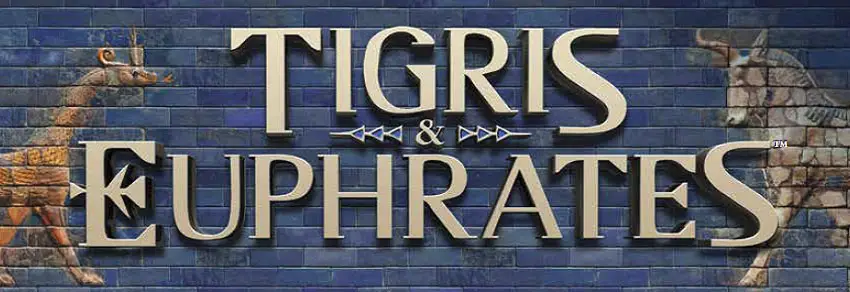Tigris & Euphrates Board Game Review
Overview:
Name of the game: Tigris & Euphrates
BGG Weight: 3.50 / 5
Year Published: 1997
Publisher: Hans im Glück
Designer: Reiner Knizia
Number of players: 2-4
Playing time: 90-120 minutes
Game category/theme: Civilization Building, Tile Placement, Area Control
Mechanics: Area Majority / Influence, Connections, Hand Management, Hidden Victory Points, Highest-Lowest Scoring
Ratings:
Strategy: 9.2
Complexity: 8.5
Player Interaction: 9.0
Replayability: 9.1
Game Rating: 9.3
Cost: 5.0
Calculations:
Weight Rating: 8.5 + 9.2 = 17.7
Playability Rating: [(9.1 + 9.0 + 9.3) – 8.5] = 18.9
Play Rating Score: (17.7 + 18.9) x 2 = 73.2
Value Rating: 73.2 / 5.0 = 14.64
Final Score Rating: 73.2 + 14.64 = 87.84
Review:
Tigris & Euphrates is a classic strategy game that challenges players to build civilizations by placing tiles on a board representing the Tigris and Euphrates rivers. Players take turns placing tiles and using their leaders to collect resources and score points. The game’s mechanics involve tile placement, hand management, set collection, area control, and action points. The game’s complexity and deep strategy make it a favorite among serious board gamers.
The game does not offer solo or cooperative play, and requires at least two players to play. The player interaction is constant, as players can attack each other and compete for resources and territory. The replayability is high, as the game is different each time it is played due to the tile placement and the different strategies players can use.
The game’s components are of high quality, and the artwork is beautiful. However, the game’s cost can be a drawback for some players, as it is more expensive than many other board games.
For those who enjoy Tigris & Euphrates, here are 10 other games that may appeal to them:
- Through the Ages: A New Story of Civilization – A complex civilization-building game with card drafting and resource management.
- Puerto Rico – A classic resource management game with role selection and city-building elements.
- Agricola – A farming game with worker placement and resource management.
- Scythe – A strategy game with area control and resource management set in an alternate history 1920s Europe.
- Twilight Struggle – A two-player game that simulates the Cold War with card-driven gameplay and area control.
- Power Grid – A game of economics and resource management where players compete to power cities and expand their networks.
- Brass: Birmingham – A game of industrial development set in England during the Industrial Revolution, with economic simulation and network building elements.
- Terra Mystica – A game of area control and resource management with fantasy races competing to terraform and control a mythical world.
- Eclipse – A 4X space game with resource management, technology development, and combat elements.
- Root – A asymmetric game of woodland warfare with variable player powers and area control mechanics
Overview:
Name of the game: Tigris & Euphrates
Year Published: 1997
Publisher: Hans im Glück
Designer: Reiner Knizia
Number of players: 2-4
Playing time: 90-120 minutes
Game category/theme: Civilization Building, Tile Placement, Area Control
Mechanics: Tile Placement, Hand Management, Set Collection, Area Control, Action Points
Ratings:
Strategy: 9.2
Complexity: 8.5
Player Interaction: 9.0
Replayability: 9.1
Game Rating: 9.3
Cost: 5.0
Calculations:
Weight Rating: 8.5 + 9.2 = 17.7
Playability Rating: [(9.1 + 9.0 + 9.3) – 8.5] = 18.9
Play Rating Score: (17.7 + 18.9) x 2 = 73.2
Value Rating: 73.2 / 5.0 = 14.64
Final Score Rating: 73.2 + 14.64 = 87.84
Review:
Tigris & Euphrates is a classic strategy game that challenges players to build civilizations by placing tiles on a board representing the Tigris and Euphrates rivers. Players take turns placing tiles and using their leaders to collect resources and score points. The game’s mechanics involve tile placement, hand management, set collection, area control, and action points. The game’s complexity and deep strategy make it a favorite among serious board gamers.
The game does not offer solo or cooperative play, and requires at least two players to play. The player interaction is constant, as players can attack each other and compete for resources and territory. The replayability is high, as the game is different each time it is played due to the tile placement and the different strategies players can use.
The game’s components are of high quality, and the artwork is beautiful. However, the game’s cost can be a drawback for some players, as it is more expensive than many other board games.
For those who enjoy Tigris & Euphrates, here are 10 other games that may appeal to them:
- Through the Ages: A New Story of Civilization – A complex civilization-building game with card drafting and resource management.
- Puerto Rico – A classic resource management game with role selection and city-building elements.
- Agricola – A farming game with worker placement and resource management.
- Scythe – A strategy game with area control and resource management set in an alternate history 1920s Europe.
- Twilight Struggle – A two-player game that simulates the Cold War with card-driven gameplay and area control.
- Power Grid – A game of economics and resource management where players compete to power cities and expand their networks.
- Brass: Birmingham – A game of industrial development set in England during the Industrial Revolution, with economic simulation and network building elements.
- Terra Mystica – A game of area control and resource management with fantasy races competing to terraform and control a mythical world.
- Eclipse – A 4X space game with resource management, technology development, and combat elements.
- Root – A asymmetric game of woodland warfare with variable player powers and area control mechanics
This review was provided by Open Source Artificial Intelligence programs. It uses a series of complex statement to have AI programs amalgomate their databases to produces information on board games. These reviews are completely unedited output from the AI bots.

